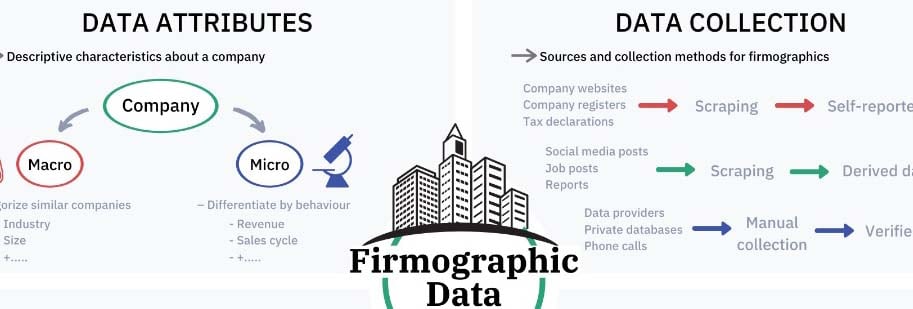
Identifying the right prospects is one of the biggest challenges in B2B sales. Businesses spend huge amounts of money on sending leads into the sales pipeline, but many of these leads are uninterested or not the right matches.
So money is lost on two sides: sourcing and chasing the lead. Here's a look at how firmographic data can save money and enhance ROI.
Human verified data for best in class accuracy
45% more opportunities created
37 million decision-makers in 70 countries
620 industries database
What is Firmographic Data?
Firmographic data is knowledge about the attributes of firms that are used to categorize certain firms into useful market segments. Firmographics are closely related to demographics, but they are specifically applicable to firms.
Some basic examples of firmographic data include the following:
- Geographic area
- Industry (SIC Code, NAICS Code)
- Revenue
- Number of Employees
- Type (Public, Private, Subsidiary)
- Fortune Ranking
This firmographic data is necessary to successfully generate, manage, and nurture leads. A sales team can use this to customize their pitch and approach to a specific prospect.
For example, imagine the difference that Salesforce manage its communication with its prospects, depending on their prospect size and scale. The response will be different.
Any experienced sales professional will know that any additional knowledge of the prospect is very helpful. This data can be used to guide the sales pitch, so it is no surprise that some companies decide to invest large amounts in the acquisition of firmographic data. As we will see, firmographic data effectively pays for itself.
Firmographic data is very helpful, but you must collect the appropriate information. And here's a look at the most important selection of firmographic data.
The purpose of firmographics
Reveal business insight
Firmographic data enables businesses to gain insight into the targeted B2B markets by helping them solve the most frequently asked question as follows;
- How many employees do they employ?
- Where are the companies in this target market located geographically?
- What’s the value of each business?
Categorize firms by industry
Firmographic data helps B2B businesses classify their prospects organizations exactly by type of business in their target markets.
For example, technology firms have very different defining features than educational firms or government entities. Accordingly, these companies should be marketed and sold differently based on the niche industry.
Optimize marketing strategies
By promoting effectively customized and targeted messaging that is better aligned with the pain points of businesses in each market segment, a company can be optimistic in its sales and marketing approach.
Sending the right message to the right prospect at the right time is the strategic tactic that businesses are aiming for, and firmographic data is of great assistance in achieving this goal.
Avoid lost opportunities
Following a knowledgeable sales strategy and optimizing data-backed marketing tactics reduces a firm's possibility of missing out on opportunities.
Understand trends in data
Evaluation of analytics and analysis from segmented markets based on firmographic data helps professionals to understand business patterns. And these trends than can easily be accounted for during sales and marketing efforts, finally improving the efficacy of these efforts.
Firmographic data is very important and very helpful, but you must collect the correct information. Here is the look at the most significant firmographic data to be gathered.
The Most Important Firmographic Data to Gather
Like demographics, some of the datasets are more informative than others. It is important to know that this list of the most important firmographic datasets will vary depending on your business and your market segment.
For example, let's say you're selling an enterprise project management tool so it's vitally important to know whether your leads are running Windows or Mac. However, this data might not be as important to other businesses.
Here's a look at the most important aspects of the firmographic data:
Type of Firm
It's important to recognize the type of business you're dealing with. The competency of a specific firm may sometimes depend on these requirements, and your strategy will certainly depend on that.
Here’s a look at some of the most common types of firms:
- Non-governmental organizations
- Nonprofit organizations
- Retail stores
- Independent contractors
- Branches
- Public vs Private companies
- Subsidiaries
- Educational Institutes
- Governmental bodies
Depending on your firm, your sales strategy can vary. The messaging and approach you use will change and some firms will also have a price structure that differs based on the type of business they work with.
Industry
The firm's business sector may sometimes specify if they have a relevant outlook, what their motives are, and how best to customize your products or services to them.
Here’s a look at some of the most common industries:
- Manufacturing
- Automotive
- Healthcare
- Construction
- Mining
- Finance
- Insurance
- Retail Services
- Real Estate
- Transportation
- Agriculture
- and more...
Since each industry is distinct, you may find that you are dealing exclusively with some or avoiding others. It is common for many companies to operate entirely within one industry, which is why this firmographic data is important when collecting potential leads.
Annual Revenue
Does your prospect qualify in terms of annual revenue? If this information is provided to you, it will give you a good impression of whether the prospect is feasible.
When sorting through potential prospects, this quantifiable metric can act as a large binary filter which is one of the most important parts of firmographic data. While it might not be accessed directly, there will be ways to quantify it so that you can make a prediction.
Size
Companies of various sizes will find reverberations with different communication and messaging styles. For example, marketing communications that are most effective when directed to a brick and mortar store will not be as effective when directed to a larger enterprise-level organization.
Segmenting the market by the size of the companies that comprise it allows more effective customized marketing and sales efforts.
Location
Based on your product, this might not be a determinant. That said, it might help you find the best times to steer your products. Aspects such as weather, tourist traffic, and other factors may make this helpful in the sales and marketing process.
How to Use Firmographic Data to Improve Your Sales
It's one thing to have some firmographic data, but the other is to use this to efficiently enhance your sales process.
Obtain Quality Data
The first important step in the effective use of firmographic data is to make sure that only the richest and most accurate data is obtained. And if you're using the wrong data that isn't reliable to tell your decisions, you could detail your sales enclosure.
Before collecting firmographic data, make sure that you have a strategy in place. This strategy will decide what information you want and how it will be used to shape your entire sales process. With a well-developed, high-profile framework in place, your firmographic data will help you close more sales deals.
Segment Prospects
With your information in your hands, it's time to begin segmenting your prospects. Try to think about how you can process this information in a way that will help the sales team to perform better.
Let's claim that your company is targeting midsize agricultural companies. You could filter the data in such a way as to offer priority labels to businesses that meet those two criteria. As a result, they will be sent to your qualified sales expert so that you can find appropriate ways to look at data which can be very beneficial to your sales efforts and increase your revenue.
Analyze Potential ROI
Firmographic data can be used to evaluate the ROI level that can be intended if your sales team confirms a deal with a specific prospect. This tactic is a very exciting way of putting your prospects in order and making better use of your firmographic data.
Although you may have a great idea of key prospects in your zone, you can receive very useful data that will help you emphasize and share opportunities with your sales team. This data is also very helpful from a strategic perspective, as it enables the C-suite to distribute budgets and make yearly predictions.
Personalize and automate marketing efforts
Firmographic data could be used to assist you to manage your pitch and marketing efforts. Let's imagine that you are running a large PR firm that aims to work on worldwide projects. Your entire marketing strategy will differ depending on whether you're pitching to large businesses or non-governmental organizations. Knowledgeable use of firmographic data can help you determine on a more suitable approach depending on the type of firm you are approaching.
Target your audience effectively
Firmographic data is good when it comes to targeting your audience. You will no longer rely on instinct or call your prospects for a temporary basis looking to make a sale.
Let's say that you want to market or call on your top 50 customers to spend their time in the office products sector, in Seattle with Essentials as your major competitor and over 100 employees. Good use of firmographics data will make that information available to you at any time without any responsibility of trawling through invoices, spreadsheets and prospective businesses.
If you segment your target audience based on firmographics data, you'll be able to easily identify pain points, needs, concerns and goals across similar potential businesses, making these all-important first phone calls much more effective.
Don’t Lose Sight of User Needs
While firmographics data may be very useful, don't let it become your only beacon of light. And, as a sales representative, you should use firmographics data as one of the tools in your stock. Some businesses fall into the trap of relying too much on firmographics data and they lose sight of the desires of their prospects.
Conclusion:
More than ever, firmographic data is very important and businesses are switching to this effective tool to boost their sales growth. I hope that you find this clear picture of firmographic data to be beneficial.



